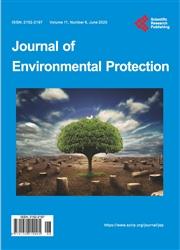Evaluation of Groundwater Quality in the Deep Maastrichtian Aquifer of Senegal Using Multivariate Statistics and Water Quality Index-Based GIS
引用次数: 1
Abstract
A regional groundwater quality evaluation was conducted in the deep Maas-trichtian aquifer of Senegal through multivariate statistical analysis and a GIS-based water quality index using physicochemical data from 232 boreholes distributed over the whole country. The aim was to 1) identify the water types and likely factors influencing the hydrochemistry, and 2) determine the suitability of groundwater for drinking and irrigation. Results showed that sodium, chloride, and fluoride are highly correlated with electrical conductivity (EC) reflecting the significant contribution of these elements to groundwater mineralization. The principal component analysis evidenced: 1) salinization processes (loaded by Na + , K + , EC, Cl − , F − and 3 HCO − ) controlled by water/rock interaction, seawater intrusion and cation exchange reactions; 2) dolomite dissolution loaded by the couple Ca 2+ and Mg 2+ and 3) localized mixing with upper aquifers and gypsum dissolution respectively loaded by 3 NO − and 24 SO − . The hierarchical clustering analysis distinguished four clusters: 1) freshwater (EC = 594 µs/cm) with mixed-HCO 3 water type and ionic contents below WHO standard; 2) brackish (Na-mixed) water type with moderate mineralization content (1310 µs/cm), 3) brackish (Na-Cl) water基于多元统计和水质指数GIS的塞内加尔马斯特里赫特深层含水层地下水质量评价
利用分布在塞内加尔全国的232个钻孔的理化数据,通过多元统计分析和基于gis的水质指数,对塞内加尔马斯特里赫特深层含水层进行了区域地下水质量评价。目的是1)确定水的类型和可能影响水化学的因素,2)确定地下水是否适合饮用和灌溉。结果表明,钠、氯、氟元素与电导率(EC)高度相关,反映了这些元素对地下水矿化的重要贡献。主成分分析表明:1)盐渍化过程(Na +、K +、EC、Cl−、F−和3hco−)受水岩相互作用、海水侵入和阳离子交换反应控制;2) Ca 2+和Mg 2+耦合加载白云岩溶蚀;3)上部含水层局部混合和石膏溶蚀分别由3 NO−和24 SO−加载。分层聚类分析可区分出4个聚类:1)淡水(EC = 594µs/cm),混合型hco3水,离子含量低于WHO标准;2)矿化度中等(1310µs/cm)的半咸淡水(na -混合)水类型;3)本研究中使用的半咸淡水(Na-Cl)水方法对评价饮用和灌溉地下水质量有价值,可用于其他地区的区域研究,特别是在浅层和脆弱含水层。
本文章由计算机程序翻译,如有差异,请以英文原文为准。
求助全文
约1分钟内获得全文
求助全文

 求助内容:
求助内容: 应助结果提醒方式:
应助结果提醒方式:


